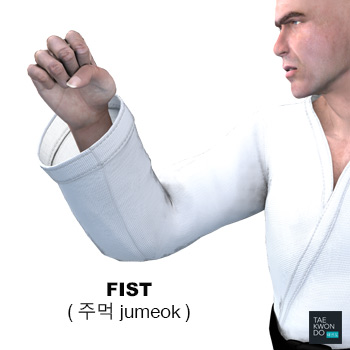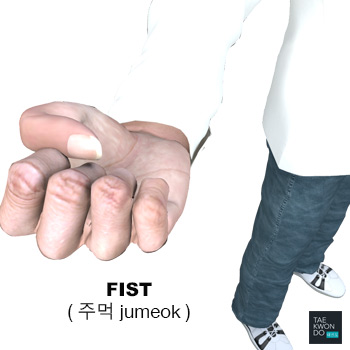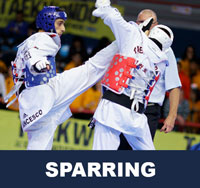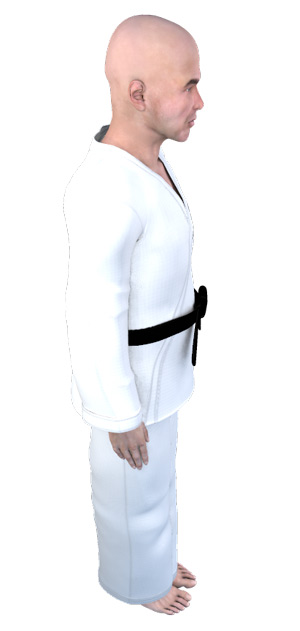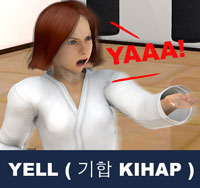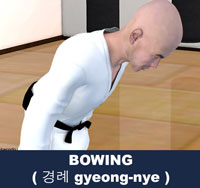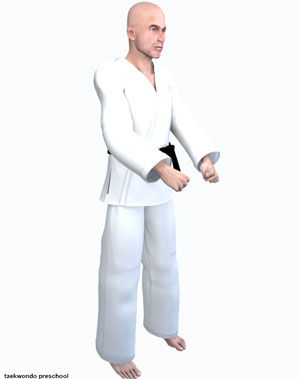Taekwondo 태권도Taekwondo Preschool
Promotion from one geup to the next can proceed rapidly in some schools, since schools often allow geup promotions every two, three, or four months. Students of geup rank learn the most basic techniques first, and then move on to more advanced techniques as they approach first dan. Many of the older and more traditional schools often take longer to allow students to test for higher ranks than newer, more contemporary schools, as they may not have the required testing intervals. View Taekwondo belt levels »
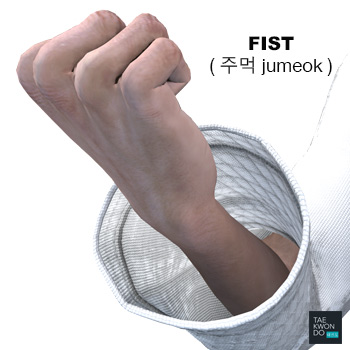
Fist
( 주먹 jumeok )
Difficulty Level: Beginner Surface: Offensive and Defensive
A fist (주먹 jumeok) is an action where a hand has the fingers curled into the palm and the thumb retracted, displaying the knuckles. The act of creating a fist is known as 'making a fist' or 'clenching a fist'. Focus on the tightening of the muscles of the hand while you clench a fist. The wrist must also be kept straight in proper alignment during the posture. If the wrist bends on impact, it can easily be sprained, dislocated or broken. Fighters tape their wrists to reduce wrist flex.
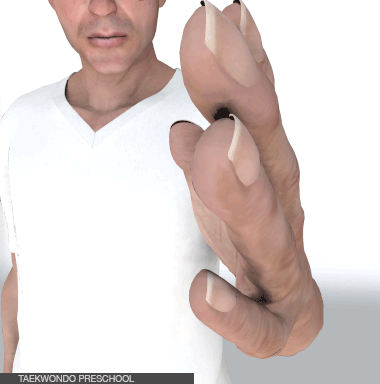
Suitable striking surfaces are the knuckles of the middle finger and index finger during the Fist Punch ( 주먹 지르기 jumeok-jireugi ), or the bottom of the hand during the Hammer Fist Strike ( 메주먹 치기 mejumeok-chigi ).
The human hand is made up of many small bones which may be damaged by heavy impact. If a hard part of the opponent's body or other hard object is inadvertently struck, the metacarpals may splay on impact and break. Fighters tape their hands so as to hold the metacarpals together and keep them from splaying. One can toughen one's bones by striking objects to induce osteoclasts (cells which remove bone) and osteoblasts (which form bone) to remodel the bone over the struck area increasing the density of bone at the striking surface.
Fight 100% says "more than 90% of the people actually don't know how to make a fist correctly", and adds that correct formation means the user "won't break [their] hand", "won't strain their wrist", will "be able to launch very powerful punches", and "be able to knock someone out in one punch".
Taekwondo hand strikes such as the Fist Punch ( 주먹 지르기 jumeok-jireugi ) are performed as a close distance alternative to kicks. They are executed in a number of ways - from standing, jumping, spinning and rushing forwards. Hand strikes make up fast combinations of strikes which can leave an opponent stunned and unable to defend himself. The knuckles of the middle finger and index finger are the striking surfaces during the fist punch. Fists are taught in most martial arts like karate, kung fu, and taekwondo for the process of punching and striking.
Some studies have shown that making fists can help humans to cope with stress or anxiety because the mind gets preoccupied with the tightening of the muscle to focus on the issue at hand.
Some techniques that utilize the fist (주먹 jumeok);
- Fist Punch ( 주먹 지르기 jumeok-jireugi )
- Front Hand Middle Punch ( 몸통 반대 지르기 momtong-bandae-jireugi )
- Rear Hand Middle Punch ( 몸통 바로 지르기 momtong-baro-jireugi )
- Vertical Punch ( 세워지르기 sewo-jireugi )
- Turning Punch ( 돌려지르기 dollyeo-jireugi )
- 'C' Shape Punch ( ‘ㄷ’자지르기 digeutja-jireugi )
- Target Punch ( 표적지르기 pyojeok-jireugi )
- Fork Punch ( 쳇다리지르기 chetdar-jireugi )
- Lift Punch ( 치지르기 chi-jireugi )
- Pulling and Punching ( 당겨지르기 danggyeo-jireugi )
- Side Punch ( 옆지르기 yeop-jireugi )
- Turn Over Punch ( 젖혀지르기 jeocheo-jireugi )
- Downward Punch ( 내려지르기 naeryeo-jireugi )
- Scissors Kick ( 가위차기 kawi-chagi )
For more information see Closed hand fist strikes ( 지르기 jireugi) »
Training Methods
How well one improves with training depends on several factors, such as the frequency it is engaged in, and the type of feedback that is available for improvement. If a student does not train often enough, reinforcement fades, and he or she is likely to forget what was learned.
When learning the impact surface, it is helpful to use mirrors to observe your technique and fix your mistakes immediately. Initially, a student may need focused feedback from a certified Master Instructor ( 사범님 sabeomnim ); however, as they progress, they must develop the ability to self-assess the impact surface.
* Please see a certified Master Instructor ( 사범님 sabeomnim ) for training. Proper guidance and instructions are needed to ensure safe training.

Impact Surface Area
Various surfaces of the hand and feet may be engaged as the striking or blocking surface depending on which area of the opponents body is being targeted. This leads to a large array of hand and feet positions. The human body's shape is determined by a strong skeleton made of bone and cartilage, surrounded by fat, muscle, connective tissue, organs, and other structures. For more information View Impact Surface Area »
- Fist ( 주먹 jumeok )
- Hammer Fist ( 메주먹 mejumeok )
- Hand Blade ( 손날 sonnal )
- Ridgehand ( 손날등 sonnal-deung )
- Forearm ( 앞팔 ap-pal )
- Inner Wrist ( 안팔목 anpalmok )
- Outside Wrist ( 바깥팔목 bakkatpalmok )
- Elbow ( 팔굽 palgup )
- Back Knuckle ( 등주먹 deung-jumeok )
- Arm ( 팔 pal )
- Hand ( 손 son )
- Finger ( 손가락 songalag )
- Palm ( 손바닥 sonbadak )
- Palm Heel ( 바탕손 batangson )
- Fingertips ( 손끝 sonkkeut )
- Scissors Fingertips ( 가위손끝 kawisonkkeut )
- Combined Two Fingertips ( 모은두손끝 moeundusonkkeut )
- Single Fingertip ( 한손끝 hansonkkeut )
- Combined Three Fingertips ( 모은세손끝 moeunsesonkkeut )
- Flat Fingertips ( 편손끝 pyeonsonkkeut )
- Back Hand ( 손등 sondeung )
- Wrist Area ( 팔목 palmok )
- Back of the Wrist ( 등팔목 deung-palmok )
- Base of the Wrist or Inner Wrist ( 밑팔목 mitpalmok )
- Arc Hand ( 아금손 ageumson )
- Pincers Finger ( 집게주먹 jipgejumeok )
- Bent Wrist ( 굽힌손목 gupinsonmok )
- Curled Fingertips ( 모둠손끝 modumsonkkeut )
- Extended Knuckle Fist ( 밤주먹 bamjumeok )
- Half-clenched Fist ( 편주먹 pyeonjumeok )
- Trigger Finger Fist ( 집게밤주먹 jipgebamjumeok )
- Curled Hand ( 곰손 gomson )
- Foot ( 발 bal )
- Ball of the Foot ( 앞축 apchuk )
- Instep of the Foot ( 발등 baldeung )
- Bottom of the Heel ( 뒤축 dwichuk )
- Sole of the Foot ( 발바닥 balbadak )
- Foot Blade ( 발날 balnal )
- Shin ( 정강이 jeonggangi )
- Ankle ( 발목 balmog )
- Reverse Foot Blade ( 발날등 balnaldeung )
- Tips of the Toes ( 발끝 balkkeut )
- Knee ( 무릎 mureup )
- Back of the Heel ( 뒤꿈치 dwikkumchi )
- Back of the Knee ( 오금 ogum )
- Thigh ( 허벅지 heobeokji )
- Head ( 머리 meoli )
- Face ( 얼굴 eolgul )
- Human Eye ( 눈 nun )
- Ear ( 귀 gwi )
- Temple ( 관자놀이 gwanjanoli )
- Nose ( 코 ko )
- Teeth ( 이 i )
- Chin ( 턱 teog )
- Jaw ( 턱 teog )
- Throat ( 목구멍 mokgumeong )
- Neck ( 목 mok )
- Cervical Vertebrae ( 경추 gyeongchu )
- Shoulder ( 어깨 eokkae )
- Collarbone ( 쇄골 swaegol )
- Chest ( 가슴 gaseum )
- Ribs ( 늑골 neuggol )
- Sternum ( 흉골 hyung-gol )
- Abdomen ( 복부 bogbu )
- Groin ( 샅 sat )
- Hamstring ( 햄스트링 haemseuteuling )
There are five tenets defined in the International Taekwondo Federation (ITF) and several more in World Taekwondo (WT).
Indomitable Spirit ( 백절불굴 baekjul-boolgool ): "To have indomitable spirit means to have the courage to stand up for what you believe in, no matter what odds you are up against, and to always give 100% effort in whatever you do." View Taekwondo Tenets »
RESOURCES
This article uses material from the Wikipedia articles "Fist (hand)" and "List of Taekwondo techniques", which is released under the Creative Commons Attribution-Share-Alike License 3.0.


